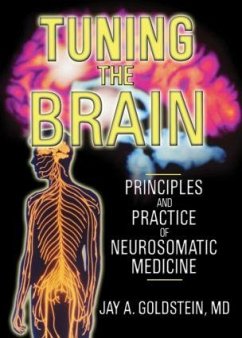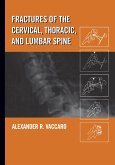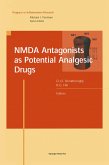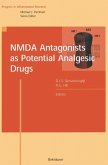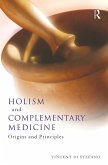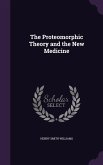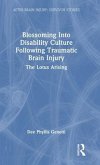Schade – dieser Artikel ist leider ausverkauft. Sobald wir wissen, ob und wann der Artikel wieder verfügbar ist, informieren wir Sie an dieser Stelle.
- Gebundenes Buch
- Merkliste
- Auf die Merkliste
- Bewerten Bewerten
- Teilen
- Produkt teilen
- Produkterinnerung
- Produkterinnerung
In this remarkable volume, Dr. Jay A. Goldstein clearly presents both the theoretical and the practical aspects of this revolutionary approach to treating CFS and other conditions that have often been termed psychosomatic. Dr. Goldstein will show you how he achieves results for patients with CFS and a variety of other syndromes in days, rather than months or years. From the most basic questions--"What is neurosomatic medicine?" and "How can treatments sometimes work so rapidly?"--to specific technical concerns--"What is receptor profiling, and how does it indicate the type of receptor…mehr
Andere Kunden interessierten sich auch für
![Fractures of the Cervical, Thoracic, and Lumbar Spine Fractures of the Cervical, Thoracic, and Lumbar Spine]() Alexander R. VaccaroFractures of the Cervical, Thoracic, and Lumbar Spine267,99 €
Alexander R. VaccaroFractures of the Cervical, Thoracic, and Lumbar Spine267,99 €![NMDA Antagonists as Potential Analgesic Drugs NMDA Antagonists as Potential Analgesic Drugs]() D.J.S. Sirinathsinghji / R.G. HillNMDA Antagonists as Potential Analgesic Drugs77,99 €
D.J.S. Sirinathsinghji / R.G. HillNMDA Antagonists as Potential Analgesic Drugs77,99 €![NMDA Antagonists as Potential Analgesic Drugs NMDA Antagonists as Potential Analgesic Drugs]() NMDA Antagonists as Potential Analgesic Drugs77,99 €
NMDA Antagonists as Potential Analgesic Drugs77,99 €![Holism and Complementary Medicine Holism and Complementary Medicine]() Vincent Di StefanoHolism and Complementary Medicine151,99 €
Vincent Di StefanoHolism and Complementary Medicine151,99 €![The Proteomorphic Theory and the New Medicine The Proteomorphic Theory and the New Medicine]() Henry Smith WilliamsThe Proteomorphic Theory and the New Medicine36,99 €
Henry Smith WilliamsThe Proteomorphic Theory and the New Medicine36,99 €![How to Treat the Sick Without Medicine How to Treat the Sick Without Medicine]() James Caleb JacksonHow to Treat the Sick Without Medicine40,99 €
James Caleb JacksonHow to Treat the Sick Without Medicine40,99 €![Blossoming Into Disability Culture Following Traumatic Brain Injury Blossoming Into Disability Culture Following Traumatic Brain Injury]() Dee Phyllis GenettiBlossoming Into Disability Culture Following Traumatic Brain Injury160,99 €
Dee Phyllis GenettiBlossoming Into Disability Culture Following Traumatic Brain Injury160,99 €-
-
In this remarkable volume, Dr. Jay A. Goldstein clearly presents both the theoretical and the practical aspects of this revolutionary approach to treating CFS and other conditions that have often been termed psychosomatic. Dr. Goldstein will show you how he achieves results for patients with CFS and a variety of other syndromes in days, rather than months or years. From the most basic questions--"What is neurosomatic medicine?" and "How can treatments sometimes work so rapidly?"--to specific technical concerns--"What is receptor profiling, and how does it indicate the type of receptor dysregulation in an individual patient?"--Tuning the Brain: Principles and Practice of Neurosomatic Medicine provides the answers in a clear and cogent manner. You'll learn which abnormalities in brain function produce neurosomatic disorders and how an understanding of these abnormalities can help you provide effective treatment.
Produktdetails
- Produktdetails
- Verlag: Taylor & Francis
- Seitenzahl: 664
- Erscheinungstermin: 23. Januar 2004
- Englisch
- Abmessung: 223mm x 161mm x 47mm
- Gewicht: 1197g
- ISBN-13: 9780789022455
- ISBN-10: 0789022451
- Artikelnr.: 21654148
- Herstellerkennzeichnung
- Libri GmbH
- Europaallee 1
- 36244 Bad Hersfeld
- gpsr@libri.de
- Verlag: Taylor & Francis
- Seitenzahl: 664
- Erscheinungstermin: 23. Januar 2004
- Englisch
- Abmessung: 223mm x 161mm x 47mm
- Gewicht: 1197g
- ISBN-13: 9780789022455
- ISBN-10: 0789022451
- Artikelnr.: 21654148
- Herstellerkennzeichnung
- Libri GmbH
- Europaallee 1
- 36244 Bad Hersfeld
- gpsr@libri.de
Jay Goldstein
* Foreword
* Preface
* Abbreviations
* Part I: Inventing Neurosomatic Medicine: Rewards and Satisfactions
versus Problems and Pitfalls
* Chapter 1. The Education of a Neurosomaticist
* Chapter 2. The Office Practice of Neurosomatic Medicine
* Bankruptcy Despite a Three-Month Waiting List
* Solving the Problems and Avoiding the Pitfalls
* Taking Care of Business
* Chapter 3. Lawyers and Litigation
* Sample Pathophysiology of Posttraumatic Fibromyalgia
* Mene, Mene, Tekel, Upharsin
* Chapter 4. Treatment Case Examples
* Instantaneous Neural Network Reconfiguration by Pharmacologic
Modulation of Afferent Cranial Nerve Input
* The Pathophysiology of CFS and Related Neurosomatic Disorders
* Thyroid Function in Neurosomatic Disorders: Stimulation of Trigeminal
Nerve Activity with Thyrotropin-Releasing Hormone (TRH)
* Chapter 5. Case Reports
* My So-Called Illness: Is It Real or All in My Head?
* One-Second Epiphanies
* My Most Unusual Case
* Bug-of-the-Month Club
* Chapter 6. Married to a Doctor Who Is Married to His Practice
* Part II: Society for Neuroscience Conference Proceedings
* Chapter 7. This Is . . . Los Angeles
* Chapter 8. Neurosomatic Pearls
* Eldritch Lore About Neurosomatic Therapy
* Chapter 9. Neurosomatic Neuroscience
* Part III: Pathophysiology and Treatment
* Chapter 10. Treatment of Neurosomatic Disorders
* Abecarnil and Acamprosate
* Stimulants
* The Corticostriatal-Thalamocortical (CSTC) Circuit in Reverse
* Corticotropin-Releasing Hormone (CRH) and Hypocortisolism
* Agmatine
* Cholinesterase Inhibitors
* Ascorbate (Vitamin C)
* Amantadine
* Adenosine
* Baclofen
* Gamma-Aminobutyric Acid (GABA)
* Adenosine Triphosphate (ATP)
* Lorazepam Nasal Spray
* Antibiotics
* Endothelin (ET)
* Respiratory Rhythm Regulation in Fibromyalgia Syndrome
* pH and Panic Disorder
* Buspirone/BuSpar
* Thalamic Reticular Nucleus
* The Attentional Network
* Clonidine
* Catecholamines
* Norepinephrine, Dopamine, Salience, and Attention
* Dopamine and Reward
* Effexor (Venlafaxine)
* Synaptic Plasticity and Long-Term Potentiation in Neurosomatic
Disorders
* The Postreceptor Phosphorylation Cascade
* The Treatment of Attentional Disorders
* Instantaneous Neural Network Reconfiguration
* Other Aspects of Synaptic Plasticity
* Hormonal Modulation in Neurosomatic Medicine
* Modulating the N-Methyl-D-Aspartate (NMDA) Receptor
* Atypical Messengers
* Synaptic Fatigue
* Glutamate Receptors, Subunits, and Synaptic Scaling
* Neurotrophic Factors
* Metabotropic Glutamate Receptors
* Conclusion
* Chapter 11. Modulating Glutamatergic Neurotransmission
* Ketamine
* Pharmacologic Modulation of Sensory Integration via the Trigeminal
Nerve
* Electroconvulsive Therapy (ECT)
* Kinases and Phosphatases
* The Nicotinic Cholinergic Receptor
* Long-Term Potentiation and Depression
* Mitogen-Activated Protein Kinases (MAPKs)
* Gabapentin
* Zolpidem
* Lamotrigine
* Pentazocine (Talwin)
* Oxytocin
* Opioids
* Oxytocin, Hypothalamic Function, and Circadian Rhythms
* Other Effects of Oxytocin
* Modafinil (Provigil)
* Ventrolateral Preoptic Nucleus (VLPO)
* Lidocaine
* Gonadotropin-Releasing Hormone (GnRH) and Dysregulation of Circadian
Rhythms
* Pyrrolidines
* Fatigue
* Sleep
* Conclusion
* Conclusion. Closing the Circuit: The Role of the Nucleus Accumbens in
Neurosomatic Disorders
* Appendix
* Diagnostic Criteria from the DSM-IV-TR
* Treatment Algorithm
* Medication List: Present and Near-Future Treatment Options for
Neurosomatic Disorders
* CFS Symptom Checklist
* References
* Index
* Preface
* Abbreviations
* Part I: Inventing Neurosomatic Medicine: Rewards and Satisfactions
versus Problems and Pitfalls
* Chapter 1. The Education of a Neurosomaticist
* Chapter 2. The Office Practice of Neurosomatic Medicine
* Bankruptcy Despite a Three-Month Waiting List
* Solving the Problems and Avoiding the Pitfalls
* Taking Care of Business
* Chapter 3. Lawyers and Litigation
* Sample Pathophysiology of Posttraumatic Fibromyalgia
* Mene, Mene, Tekel, Upharsin
* Chapter 4. Treatment Case Examples
* Instantaneous Neural Network Reconfiguration by Pharmacologic
Modulation of Afferent Cranial Nerve Input
* The Pathophysiology of CFS and Related Neurosomatic Disorders
* Thyroid Function in Neurosomatic Disorders: Stimulation of Trigeminal
Nerve Activity with Thyrotropin-Releasing Hormone (TRH)
* Chapter 5. Case Reports
* My So-Called Illness: Is It Real or All in My Head?
* One-Second Epiphanies
* My Most Unusual Case
* Bug-of-the-Month Club
* Chapter 6. Married to a Doctor Who Is Married to His Practice
* Part II: Society for Neuroscience Conference Proceedings
* Chapter 7. This Is . . . Los Angeles
* Chapter 8. Neurosomatic Pearls
* Eldritch Lore About Neurosomatic Therapy
* Chapter 9. Neurosomatic Neuroscience
* Part III: Pathophysiology and Treatment
* Chapter 10. Treatment of Neurosomatic Disorders
* Abecarnil and Acamprosate
* Stimulants
* The Corticostriatal-Thalamocortical (CSTC) Circuit in Reverse
* Corticotropin-Releasing Hormone (CRH) and Hypocortisolism
* Agmatine
* Cholinesterase Inhibitors
* Ascorbate (Vitamin C)
* Amantadine
* Adenosine
* Baclofen
* Gamma-Aminobutyric Acid (GABA)
* Adenosine Triphosphate (ATP)
* Lorazepam Nasal Spray
* Antibiotics
* Endothelin (ET)
* Respiratory Rhythm Regulation in Fibromyalgia Syndrome
* pH and Panic Disorder
* Buspirone/BuSpar
* Thalamic Reticular Nucleus
* The Attentional Network
* Clonidine
* Catecholamines
* Norepinephrine, Dopamine, Salience, and Attention
* Dopamine and Reward
* Effexor (Venlafaxine)
* Synaptic Plasticity and Long-Term Potentiation in Neurosomatic
Disorders
* The Postreceptor Phosphorylation Cascade
* The Treatment of Attentional Disorders
* Instantaneous Neural Network Reconfiguration
* Other Aspects of Synaptic Plasticity
* Hormonal Modulation in Neurosomatic Medicine
* Modulating the N-Methyl-D-Aspartate (NMDA) Receptor
* Atypical Messengers
* Synaptic Fatigue
* Glutamate Receptors, Subunits, and Synaptic Scaling
* Neurotrophic Factors
* Metabotropic Glutamate Receptors
* Conclusion
* Chapter 11. Modulating Glutamatergic Neurotransmission
* Ketamine
* Pharmacologic Modulation of Sensory Integration via the Trigeminal
Nerve
* Electroconvulsive Therapy (ECT)
* Kinases and Phosphatases
* The Nicotinic Cholinergic Receptor
* Long-Term Potentiation and Depression
* Mitogen-Activated Protein Kinases (MAPKs)
* Gabapentin
* Zolpidem
* Lamotrigine
* Pentazocine (Talwin)
* Oxytocin
* Opioids
* Oxytocin, Hypothalamic Function, and Circadian Rhythms
* Other Effects of Oxytocin
* Modafinil (Provigil)
* Ventrolateral Preoptic Nucleus (VLPO)
* Lidocaine
* Gonadotropin-Releasing Hormone (GnRH) and Dysregulation of Circadian
Rhythms
* Pyrrolidines
* Fatigue
* Sleep
* Conclusion
* Conclusion. Closing the Circuit: The Role of the Nucleus Accumbens in
Neurosomatic Disorders
* Appendix
* Diagnostic Criteria from the DSM-IV-TR
* Treatment Algorithm
* Medication List: Present and Near-Future Treatment Options for
Neurosomatic Disorders
* CFS Symptom Checklist
* References
* Index
- Foreword
- Preface
- Abbreviations
- Part I: Inventing Neurosomatic Medicine: Rewards and Satisfactions versus Problems and Pitfalls
- Chapter 1. The Education of a Neurosomaticist
- Chapter 2. The Office Practice of Neurosomatic Medicine
- Bankruptcy Despite a Three-Month Waiting List
- Solving the Problems and Avoiding the Pitfalls
- Taking Care of Business
- Chapter 3. Lawyers and Litigation
- Sample Pathophysiology of Posttraumatic Fibromyalgia
- Mene, Mene, Tekel, Upharsin
- Chapter 4. Treatment Case Examples
- Instantaneous Neural Network Reconfiguration by Pharmacologic Modulation of Afferent Cranial Nerve Input
- The Pathophysiology of CFS and Related Neurosomatic Disorders
- Thyroid Function in Neurosomatic Disorders: Stimulation of Trigeminal Nerve Activity with Thyrotropin-Releasing Hormone (TRH)
- Chapter 5. Case Reports
- My So-Called Illness: Is It Real or All in My Head?
- One-Second Epiphanies
- My Most Unusual Case
- Bug-of-the-Month Club
- Chapter 6. Married to a Doctor Who Is Married to His Practice
- Part II: Society for Neuroscience Conference Proceedings
- Chapter 7. This Is . . . Los Angeles
- Chapter 8. Neurosomatic Pearls
- Eldritch Lore About Neurosomatic Therapy
- Chapter 9. Neurosomatic Neuroscience
- Part III: Pathophysiology and Treatment
- Chapter 10. Treatment of Neurosomatic Disorders
- Abecarnil and Acamprosate
- Stimulants
- The Corticostriatal-Thalamocortical (CSTC) Circuit in Reverse
- Corticotropin-Releasing Hormone (CRH) and Hypocortisolism
- Agmatine
- Cholinesterase Inhibitors
- Ascorbate (Vitamin C)
- Amantadine
- Adenosine
- Baclofen
- Gamma-Aminobutyric Acid (GABA)
- Adenosine Triphosphate (ATP)
- Lorazepam Nasal Spray
- Antibiotics
- Endothelin (ET)
- Respiratory Rhythm Regulation in Fibromyalgia Syndrome
- pH and Panic Disorder
- Buspirone/BuSpar
- Thalamic Reticular Nucleus
- The Attentional Network
- Clonidine
- Catecholamines
- Norepinephrine, Dopamine, Salience, and Attention
- Dopamine and Reward
- Effexor (Venlafaxine)
- Synaptic Plasticity and Long-Term Potentiation in Neurosomatic Disorders
- The Postreceptor Phosphorylation Cascade
- The Treatment of Attentional Disorders
- Instantaneous Neural Network Reconfiguration
- Other Aspects of Synaptic Plasticity
- Hormonal Modulation in Neurosomatic Medicine
- Modulating the N-Methyl-D-Aspartate (NMDA) Receptor
- Atypical Messengers
- Synaptic Fatigue
- Glutamate Receptors, Subunits, and Synaptic Scaling
- Neurotrophic Factors
- Metabotropic Glutamate Receptors
- Conclusion
- Chapter 11. Modulating Glutamatergic Neurotransmission
- Ketamine
- Pharmacologic Modulation of Sensory Integration via the Trigeminal Nerve
- Electroconvulsive Therapy (ECT)
- Kinases and Phosphatases
- The Nicotinic Cholinergic Receptor
- Long-Term Potentiation and Depression
- Mitogen-Activated Protein Kinases (MAPKs)
- Gabapentin
- Zolpidem
- Lamotrigine
- Pentazocine (Talwin)
- Oxytocin
- Opioids
- Oxytocin, Hypothalamic Function, and Circadian Rhythms
- Other Effects of Oxytocin
- Modafinil (Provigil)
- Ventrolateral Preoptic Nucleus (VLPO)
- Lidocaine
- Gonadotropin-Releasing Hormone (GnRH) and Dysregulation of Circadian Rhythms
- Pyrrolidines
- Fatigue
- Sleep
- Conclusion
- Conclusion. Closing the Circuit: The Role of the Nucleus Accumbens in Neurosomatic Disorders
- Appendix
- Diagnostic Criteria from the DSM-IV-TR
- Treatment Algorithm
- Medication List: Present and Near-Future Treatment Options for Neurosomatic Disorders
- CFS Symptom Checklist
- References
- Index
* Foreword
* Preface
* Abbreviations
* Part I: Inventing Neurosomatic Medicine: Rewards and Satisfactions
versus Problems and Pitfalls
* Chapter 1. The Education of a Neurosomaticist
* Chapter 2. The Office Practice of Neurosomatic Medicine
* Bankruptcy Despite a Three-Month Waiting List
* Solving the Problems and Avoiding the Pitfalls
* Taking Care of Business
* Chapter 3. Lawyers and Litigation
* Sample Pathophysiology of Posttraumatic Fibromyalgia
* Mene, Mene, Tekel, Upharsin
* Chapter 4. Treatment Case Examples
* Instantaneous Neural Network Reconfiguration by Pharmacologic
Modulation of Afferent Cranial Nerve Input
* The Pathophysiology of CFS and Related Neurosomatic Disorders
* Thyroid Function in Neurosomatic Disorders: Stimulation of Trigeminal
Nerve Activity with Thyrotropin-Releasing Hormone (TRH)
* Chapter 5. Case Reports
* My So-Called Illness: Is It Real or All in My Head?
* One-Second Epiphanies
* My Most Unusual Case
* Bug-of-the-Month Club
* Chapter 6. Married to a Doctor Who Is Married to His Practice
* Part II: Society for Neuroscience Conference Proceedings
* Chapter 7. This Is . . . Los Angeles
* Chapter 8. Neurosomatic Pearls
* Eldritch Lore About Neurosomatic Therapy
* Chapter 9. Neurosomatic Neuroscience
* Part III: Pathophysiology and Treatment
* Chapter 10. Treatment of Neurosomatic Disorders
* Abecarnil and Acamprosate
* Stimulants
* The Corticostriatal-Thalamocortical (CSTC) Circuit in Reverse
* Corticotropin-Releasing Hormone (CRH) and Hypocortisolism
* Agmatine
* Cholinesterase Inhibitors
* Ascorbate (Vitamin C)
* Amantadine
* Adenosine
* Baclofen
* Gamma-Aminobutyric Acid (GABA)
* Adenosine Triphosphate (ATP)
* Lorazepam Nasal Spray
* Antibiotics
* Endothelin (ET)
* Respiratory Rhythm Regulation in Fibromyalgia Syndrome
* pH and Panic Disorder
* Buspirone/BuSpar
* Thalamic Reticular Nucleus
* The Attentional Network
* Clonidine
* Catecholamines
* Norepinephrine, Dopamine, Salience, and Attention
* Dopamine and Reward
* Effexor (Venlafaxine)
* Synaptic Plasticity and Long-Term Potentiation in Neurosomatic
Disorders
* The Postreceptor Phosphorylation Cascade
* The Treatment of Attentional Disorders
* Instantaneous Neural Network Reconfiguration
* Other Aspects of Synaptic Plasticity
* Hormonal Modulation in Neurosomatic Medicine
* Modulating the N-Methyl-D-Aspartate (NMDA) Receptor
* Atypical Messengers
* Synaptic Fatigue
* Glutamate Receptors, Subunits, and Synaptic Scaling
* Neurotrophic Factors
* Metabotropic Glutamate Receptors
* Conclusion
* Chapter 11. Modulating Glutamatergic Neurotransmission
* Ketamine
* Pharmacologic Modulation of Sensory Integration via the Trigeminal
Nerve
* Electroconvulsive Therapy (ECT)
* Kinases and Phosphatases
* The Nicotinic Cholinergic Receptor
* Long-Term Potentiation and Depression
* Mitogen-Activated Protein Kinases (MAPKs)
* Gabapentin
* Zolpidem
* Lamotrigine
* Pentazocine (Talwin)
* Oxytocin
* Opioids
* Oxytocin, Hypothalamic Function, and Circadian Rhythms
* Other Effects of Oxytocin
* Modafinil (Provigil)
* Ventrolateral Preoptic Nucleus (VLPO)
* Lidocaine
* Gonadotropin-Releasing Hormone (GnRH) and Dysregulation of Circadian
Rhythms
* Pyrrolidines
* Fatigue
* Sleep
* Conclusion
* Conclusion. Closing the Circuit: The Role of the Nucleus Accumbens in
Neurosomatic Disorders
* Appendix
* Diagnostic Criteria from the DSM-IV-TR
* Treatment Algorithm
* Medication List: Present and Near-Future Treatment Options for
Neurosomatic Disorders
* CFS Symptom Checklist
* References
* Index
* Preface
* Abbreviations
* Part I: Inventing Neurosomatic Medicine: Rewards and Satisfactions
versus Problems and Pitfalls
* Chapter 1. The Education of a Neurosomaticist
* Chapter 2. The Office Practice of Neurosomatic Medicine
* Bankruptcy Despite a Three-Month Waiting List
* Solving the Problems and Avoiding the Pitfalls
* Taking Care of Business
* Chapter 3. Lawyers and Litigation
* Sample Pathophysiology of Posttraumatic Fibromyalgia
* Mene, Mene, Tekel, Upharsin
* Chapter 4. Treatment Case Examples
* Instantaneous Neural Network Reconfiguration by Pharmacologic
Modulation of Afferent Cranial Nerve Input
* The Pathophysiology of CFS and Related Neurosomatic Disorders
* Thyroid Function in Neurosomatic Disorders: Stimulation of Trigeminal
Nerve Activity with Thyrotropin-Releasing Hormone (TRH)
* Chapter 5. Case Reports
* My So-Called Illness: Is It Real or All in My Head?
* One-Second Epiphanies
* My Most Unusual Case
* Bug-of-the-Month Club
* Chapter 6. Married to a Doctor Who Is Married to His Practice
* Part II: Society for Neuroscience Conference Proceedings
* Chapter 7. This Is . . . Los Angeles
* Chapter 8. Neurosomatic Pearls
* Eldritch Lore About Neurosomatic Therapy
* Chapter 9. Neurosomatic Neuroscience
* Part III: Pathophysiology and Treatment
* Chapter 10. Treatment of Neurosomatic Disorders
* Abecarnil and Acamprosate
* Stimulants
* The Corticostriatal-Thalamocortical (CSTC) Circuit in Reverse
* Corticotropin-Releasing Hormone (CRH) and Hypocortisolism
* Agmatine
* Cholinesterase Inhibitors
* Ascorbate (Vitamin C)
* Amantadine
* Adenosine
* Baclofen
* Gamma-Aminobutyric Acid (GABA)
* Adenosine Triphosphate (ATP)
* Lorazepam Nasal Spray
* Antibiotics
* Endothelin (ET)
* Respiratory Rhythm Regulation in Fibromyalgia Syndrome
* pH and Panic Disorder
* Buspirone/BuSpar
* Thalamic Reticular Nucleus
* The Attentional Network
* Clonidine
* Catecholamines
* Norepinephrine, Dopamine, Salience, and Attention
* Dopamine and Reward
* Effexor (Venlafaxine)
* Synaptic Plasticity and Long-Term Potentiation in Neurosomatic
Disorders
* The Postreceptor Phosphorylation Cascade
* The Treatment of Attentional Disorders
* Instantaneous Neural Network Reconfiguration
* Other Aspects of Synaptic Plasticity
* Hormonal Modulation in Neurosomatic Medicine
* Modulating the N-Methyl-D-Aspartate (NMDA) Receptor
* Atypical Messengers
* Synaptic Fatigue
* Glutamate Receptors, Subunits, and Synaptic Scaling
* Neurotrophic Factors
* Metabotropic Glutamate Receptors
* Conclusion
* Chapter 11. Modulating Glutamatergic Neurotransmission
* Ketamine
* Pharmacologic Modulation of Sensory Integration via the Trigeminal
Nerve
* Electroconvulsive Therapy (ECT)
* Kinases and Phosphatases
* The Nicotinic Cholinergic Receptor
* Long-Term Potentiation and Depression
* Mitogen-Activated Protein Kinases (MAPKs)
* Gabapentin
* Zolpidem
* Lamotrigine
* Pentazocine (Talwin)
* Oxytocin
* Opioids
* Oxytocin, Hypothalamic Function, and Circadian Rhythms
* Other Effects of Oxytocin
* Modafinil (Provigil)
* Ventrolateral Preoptic Nucleus (VLPO)
* Lidocaine
* Gonadotropin-Releasing Hormone (GnRH) and Dysregulation of Circadian
Rhythms
* Pyrrolidines
* Fatigue
* Sleep
* Conclusion
* Conclusion. Closing the Circuit: The Role of the Nucleus Accumbens in
Neurosomatic Disorders
* Appendix
* Diagnostic Criteria from the DSM-IV-TR
* Treatment Algorithm
* Medication List: Present and Near-Future Treatment Options for
Neurosomatic Disorders
* CFS Symptom Checklist
* References
* Index
- Foreword
- Preface
- Abbreviations
- Part I: Inventing Neurosomatic Medicine: Rewards and Satisfactions versus Problems and Pitfalls
- Chapter 1. The Education of a Neurosomaticist
- Chapter 2. The Office Practice of Neurosomatic Medicine
- Bankruptcy Despite a Three-Month Waiting List
- Solving the Problems and Avoiding the Pitfalls
- Taking Care of Business
- Chapter 3. Lawyers and Litigation
- Sample Pathophysiology of Posttraumatic Fibromyalgia
- Mene, Mene, Tekel, Upharsin
- Chapter 4. Treatment Case Examples
- Instantaneous Neural Network Reconfiguration by Pharmacologic Modulation of Afferent Cranial Nerve Input
- The Pathophysiology of CFS and Related Neurosomatic Disorders
- Thyroid Function in Neurosomatic Disorders: Stimulation of Trigeminal Nerve Activity with Thyrotropin-Releasing Hormone (TRH)
- Chapter 5. Case Reports
- My So-Called Illness: Is It Real or All in My Head?
- One-Second Epiphanies
- My Most Unusual Case
- Bug-of-the-Month Club
- Chapter 6. Married to a Doctor Who Is Married to His Practice
- Part II: Society for Neuroscience Conference Proceedings
- Chapter 7. This Is . . . Los Angeles
- Chapter 8. Neurosomatic Pearls
- Eldritch Lore About Neurosomatic Therapy
- Chapter 9. Neurosomatic Neuroscience
- Part III: Pathophysiology and Treatment
- Chapter 10. Treatment of Neurosomatic Disorders
- Abecarnil and Acamprosate
- Stimulants
- The Corticostriatal-Thalamocortical (CSTC) Circuit in Reverse
- Corticotropin-Releasing Hormone (CRH) and Hypocortisolism
- Agmatine
- Cholinesterase Inhibitors
- Ascorbate (Vitamin C)
- Amantadine
- Adenosine
- Baclofen
- Gamma-Aminobutyric Acid (GABA)
- Adenosine Triphosphate (ATP)
- Lorazepam Nasal Spray
- Antibiotics
- Endothelin (ET)
- Respiratory Rhythm Regulation in Fibromyalgia Syndrome
- pH and Panic Disorder
- Buspirone/BuSpar
- Thalamic Reticular Nucleus
- The Attentional Network
- Clonidine
- Catecholamines
- Norepinephrine, Dopamine, Salience, and Attention
- Dopamine and Reward
- Effexor (Venlafaxine)
- Synaptic Plasticity and Long-Term Potentiation in Neurosomatic Disorders
- The Postreceptor Phosphorylation Cascade
- The Treatment of Attentional Disorders
- Instantaneous Neural Network Reconfiguration
- Other Aspects of Synaptic Plasticity
- Hormonal Modulation in Neurosomatic Medicine
- Modulating the N-Methyl-D-Aspartate (NMDA) Receptor
- Atypical Messengers
- Synaptic Fatigue
- Glutamate Receptors, Subunits, and Synaptic Scaling
- Neurotrophic Factors
- Metabotropic Glutamate Receptors
- Conclusion
- Chapter 11. Modulating Glutamatergic Neurotransmission
- Ketamine
- Pharmacologic Modulation of Sensory Integration via the Trigeminal Nerve
- Electroconvulsive Therapy (ECT)
- Kinases and Phosphatases
- The Nicotinic Cholinergic Receptor
- Long-Term Potentiation and Depression
- Mitogen-Activated Protein Kinases (MAPKs)
- Gabapentin
- Zolpidem
- Lamotrigine
- Pentazocine (Talwin)
- Oxytocin
- Opioids
- Oxytocin, Hypothalamic Function, and Circadian Rhythms
- Other Effects of Oxytocin
- Modafinil (Provigil)
- Ventrolateral Preoptic Nucleus (VLPO)
- Lidocaine
- Gonadotropin-Releasing Hormone (GnRH) and Dysregulation of Circadian Rhythms
- Pyrrolidines
- Fatigue
- Sleep
- Conclusion
- Conclusion. Closing the Circuit: The Role of the Nucleus Accumbens in Neurosomatic Disorders
- Appendix
- Diagnostic Criteria from the DSM-IV-TR
- Treatment Algorithm
- Medication List: Present and Near-Future Treatment Options for Neurosomatic Disorders
- CFS Symptom Checklist
- References
- Index

